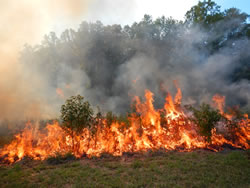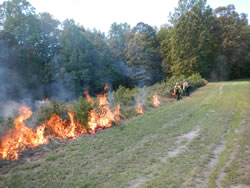National Cohesive Wildland Fire Management Strategy Success Story
Expanding Burn Windows through Growing Season Prescribed Fires
Fredericksburg and Spotsylvania National Historical Park, Virginia
Cohesive Strategy – Maintain and Restore Landscapes
2012

Prescribed fire was used to reduce woody vegetation and restore resiliency to this historic battlefield. NPS / Heather Dammeyer.

Prescribed fire project goal included restoring the battlefield landscape conditions to maintain its cultural character. NPS / Heather Dammeyer.
In September 2012, managers at Fredericksburg and Spotsylvania National Military Park implemented a growing season prescribed fire project with the goal of restoring resiliency to a Civil War battlefield, a treasured landscape, while simultaneously restoring its cultural character and condition. In the mid-Atlantic region, prescribed burning has historically been conducted during dormant season from late winter to early spring because fuels are readily available, weather conditions are typically predictable, and impacts to nesting birds and other wildlife is minimized. However, spring burning is often difficult because of a lack of local resources due to wildfires and competing prescribed fire projects throughout the region. Recent research indicates that burns in the growing season do not affect bird populations more than burns at other times of the year. As a result, prescribed fire managers have opted to add growing season periods to implement prescribed fire projects.
The main objective of the prescribed fire was to reduce woody shrub encroachment and maintain the historic scene of the battlefield. In grasslands, early to mid-summer season burns have been shown to meet management objectives by decreasing a woody plants ability to re-sprout after fire. In late summer, trees and shrubs prepare for fall dormancy and transport carbohydrates, and other compounds down from the leaves to the roots. By burning at this critical time period, the plant does not have the nutrients to pass back down to the roots and its ability to start growing the following spring is greatly diminished.
Prescribed fire conditions were optimal on burn day with warm temperatures, low relative humidity and excellent smoke dispersion. The fire readily carried through the green vegetation surprising even some of the most experienced fire personnel.
The prescribed fire was a multi-agency endeavor with cooperators from the US Fish and Wildlife Service and AmeriCorps firefighters participating in their first prescribed fire. Park employees, regional fire staff, Shenandoah National Park fire staff and Northeast Region fire militia rounded out the staffing on the burn.
This burn is an example of prescribed fire managers working with cooperators and utilizing non-traditional burn windows to accomplish a project while meeting burn objectives.
Contact: Missy Forder, Fire Ecologist, Melissa_Forder@nps.gov, (540)999-3500 x 3323
Keywords: treasured landscape, resiliency